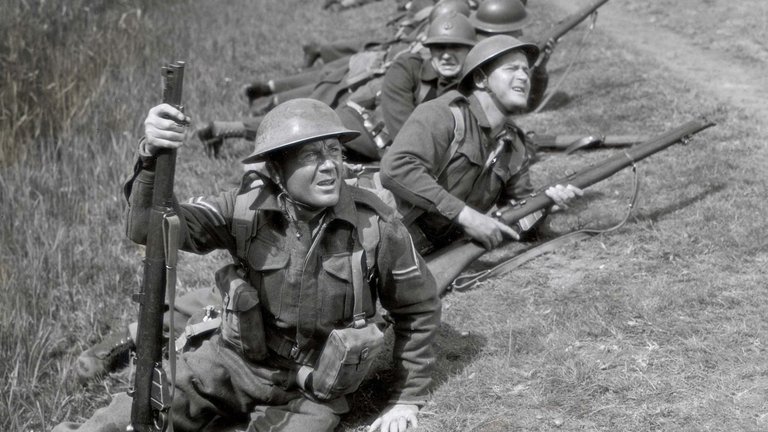
History is replete with grand fiascos that, through the lens of propaganda, mythmaking, and broader historical contexts, have been transformed into stories of triumph. One such instance is the Dunkirk evacuation during World War II, which has been immortalised in various forms of media, including the 1958 British war epic Dunkirk, directed by Leslie Norman.
The screenplay for Dunkirk is adapted from two works: The Pick-Up, a novel by Elleston Trevor, and Dunkirk, a book co-authored by Lt. Colonel Ewan Hunter and Major J. S. Bradford, both of whom served as technical advisors during the film's production.
The plot unfolds in May 1940, a mere eight months after the onset of the Second World War. At this juncture, Nazi Germany had already conquered Poland and Denmark, and was nearing the completion of its conquest of Norway. However, the Western Front remained inexplicably quiet, with the French Army facing German border stationed behind the formidable fortifications of the Maginot Line. This period, often referred to as the "Phoney War," led many in Britain and beyond to underestimate the gravity of the conflict. Among the dissenters was journalist Charles Foreman, portrayed by Bernard Lee, who disregards official Allied propaganda in favour of a more sobering reality, noting the significant German troop concentrations along the borders of neutral Belgium and the Netherlands.
As the Germans launch their invasion of these countries, intending to circumvent the Maginot Line, the Allied forces, including the British Expeditionary Force, are compelled to cross into Belgium in a bid to halt the German advance. This move plays directly into the Germans' strategic plans, resulting in a catastrophic breakthrough at the Meuse River that isolates the main Allied forces in Belgium from their supply lines in France. Consequently, the British Expeditionary Force, having barely entered Belgium, finds itself retreating to the Channel ports of northern France, clinging to the hope of evacuation back to Britain. The film depicts the plight of a small group of straggling British soldiers, led by Corporal "Tubby" Binns, played by John Mills, as they navigate the chaos of Dunkirk, besieged by Luftwaffe bombings and artillery fire, desperately seeking survival amidst dwindling defensive perimeters. Their only glimmer of hope lies in the armada of civilian boats, including one owned by Holden (played by Richard Attenborrough), an industrialist and neighbour of Foreman, who had previously shown little enthusiasm for the war effort.
Dunkirk was produced a mere eighteen years after the actual events, which presents both strengths and weaknesses. On one hand, this proximity to the events allows for a raw and immediate depiction of the Dunkirk evacuation, resonating with audiences who had lived through the war. The film's relatively modest budget did not hinder its authenticity; it benefitted from the cooperation of British and French military forces, resulting in a portrayal that feels grounded in reality. The black-and-white cinematography by Paul Beeson effectively merges live action with documentary stock footage, enhancing the film's realism. Additionally, the inclusion of wartime music hall entertainers Flanagan and Allan, who appear in the film, and their rendition of "We're Going to Hang out the Washing on the Siegfried Line" serves as an ironic commentary on the disparity between official propaganda and the bleak reality on the battlefield. The most striking scenes are those that capture the chaos and desperation on the beaches of Dunkirk, featuring hundreds of extras and effective pyrotechnic effects that convey the urgency and peril of the situation.
Conversely, Dunkirk was primarily crafted for a British audience that was already familiar with the historical context, having experienced the war firsthand and been subjected to wartime propaganda and post-war mythmaking. This familiarity resulted in a lack of exposition that would have contextualised the events for viewers less acquainted with World War II history. Consequently, the film may pose challenges for audiences outside the UK or those unfamiliar with the specifics of the Dunkirk evacuation, a problem that also affected Christopher Nolan's 2017 film of the same name.
The screenplay by David Divine attempts to portray the events from the perspectives of three distinct characters whose stories converge in the film's climax. Among these narratives, the one centring on Corporal Binns stands out, not only due to Mills' compelling performance but also because it presents a straightforward yet realistic portrayal of soldiers striving for survival. In contrast, the subplots involving Foreman and Holden, with their domestic issues, tend to veer into unnecessary melodrama.
Despite its limitations, Dunkirk resonated with its target audience, becoming a significant hit in British cinemas. Its reputation was further solidified by frequent airings on British television, ensuring its place in the national consciousness.
Inevitably, comparisons with Nolan's 2017 adaptation highlight the technical advancements in filmmaking that have occurred over the decades. While the 1958 film may appear more dated and less polished, its conventional approach offers an "old school" charm that can be more accessible for contemporary audiences. The 1958 version captures the essence of the Dunkirk spirit, balancing the chaos of battle with the resilience of a nation facing adversity.
RATING: 6/10 (++)
Blog in Croatian https://draxblog.com
Blog in English https://draxreview.wordpress.com/
InLeo blog https://inleo.io/@drax.leo
Hiveonboard: https://hiveonboard.com?ref=drax
Rising Star game: https://www.risingstargame.com?referrer=drax
1Inch: https://1inch.exchange/#/r/0x83823d8CCB74F828148258BB4457642124b1328e
BTC donations: 1EWxiMiP6iiG9rger3NuUSd6HByaxQWafG
ETH donations: 0xB305F144323b99e6f8b1d66f5D7DE78B498C32A7
BCH donations: qpvxw0jax79lhmvlgcldkzpqanf03r9cjv8y6gtmk9
Posted Using InLeo Alpha
Posted Using InLeo Alpha